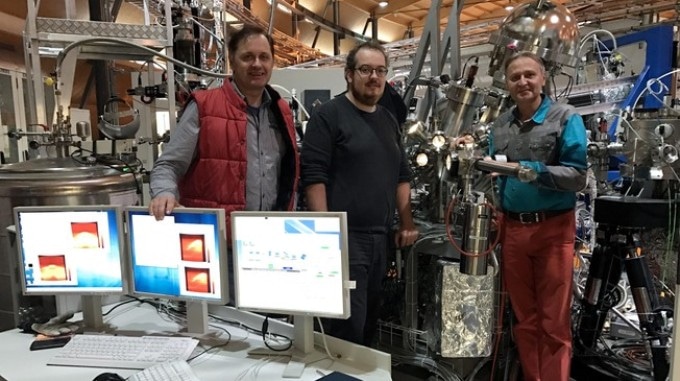Oct 24 2016
Scientists at EPFL and PSI have discovered a new class of materials that can prove ideal for the implementation of spintronics.
 Three of the study's researchers at the Swiss Light Source (Vladimir Strocov, Stefan Muff, and Juraj Krempaský) © Hugo Dil/EPFL
Three of the study's researchers at the Swiss Light Source (Vladimir Strocov, Stefan Muff, and Juraj Krempaský) © Hugo Dil/EPFL
Electron spin generally refers to the rotation of electrons around their axis. In a material electrons also orbit the atom's nucleus. When these two electron motions, spin and orbit interact, they locally produce a very strong magnetic field. As such, spin is used in MRI, NMR spectroscopy, and hard drives. Spintronics, an emerging field of technology, explores spin-orbit interactions to develop a new generation of power-saving electronics and high-capacity memory cells. Publishing in Nature Communications, scientists at EPFL and the Swiss Light Source (PSI) have now identified a new class of materials whose electronic properties can prove ideal for spintronics.
In a classical picture spin exists in either of two directions: "up" or "down", which can be described respectively as the clockwise or counter-clockwise rotation of the electron around its axis. However, the full picture is even more fascinating; the spin is a quantum property of the electron and can thus be in a superposition of up and down. Similar to the picture of Schrödingers cat being alive and dead at the same time. This makes a controllable spin state also a promising aspect for quantum computers.
Hugo Dil at EPFL together with Juraj Krempasky and Vladimir Strocov at the Paul Scherrer Institute led a study on the electronic and spin structure of a material made of Germanium and Tellurium (GeTe) and doped with Manganese (Mn). It belongs to the small class of multiferroic materials where (ferro)magnetic and (ferro)electric properties are directly coupled. In this material the combination of spin-orbit interaction and magnetism produces some exotic properties which were sought for by researchers world wide, but no for the first time are experimentally identified.
For their study, the researchers used thin films of the GeTe material, each about 200 nm thick. The researchers used a technique called photoemission, which uses the photoelectric effect predicted by Einstein and with which Dil's lab has longstanding expertise.
The study revealed the intertwined nature of the electric and magnetic properties of the new class of materials, which are termed "multiferroic Rashba semiconductors" (Rashba refers to the type of spin separation). "In multiferroic materials the electric and magnetic properties are directly linked," explains Hugo Dil. "So when we switch one the other is affected too, which paves the way to future spintronic devices, since we can switch the magnetic orientation using just a small electrical field."
On a more fundamental level, the GeTe compound used in this study shows that the electric and magnetic polarization are exactly antiparallel, unlike the few other known multiferroic materials. Furthermore, the properties extend throughout the whole of the material and are not confined to a small region. This has far-reaching implications for the way its electronic states are structured. As Hugo Dil explains: "In this case the electronic structure is similar to that of topological insulators, but then in 3D. Exactly this property forms the basis for the formation of Majorana particles to be used in quantum computers."